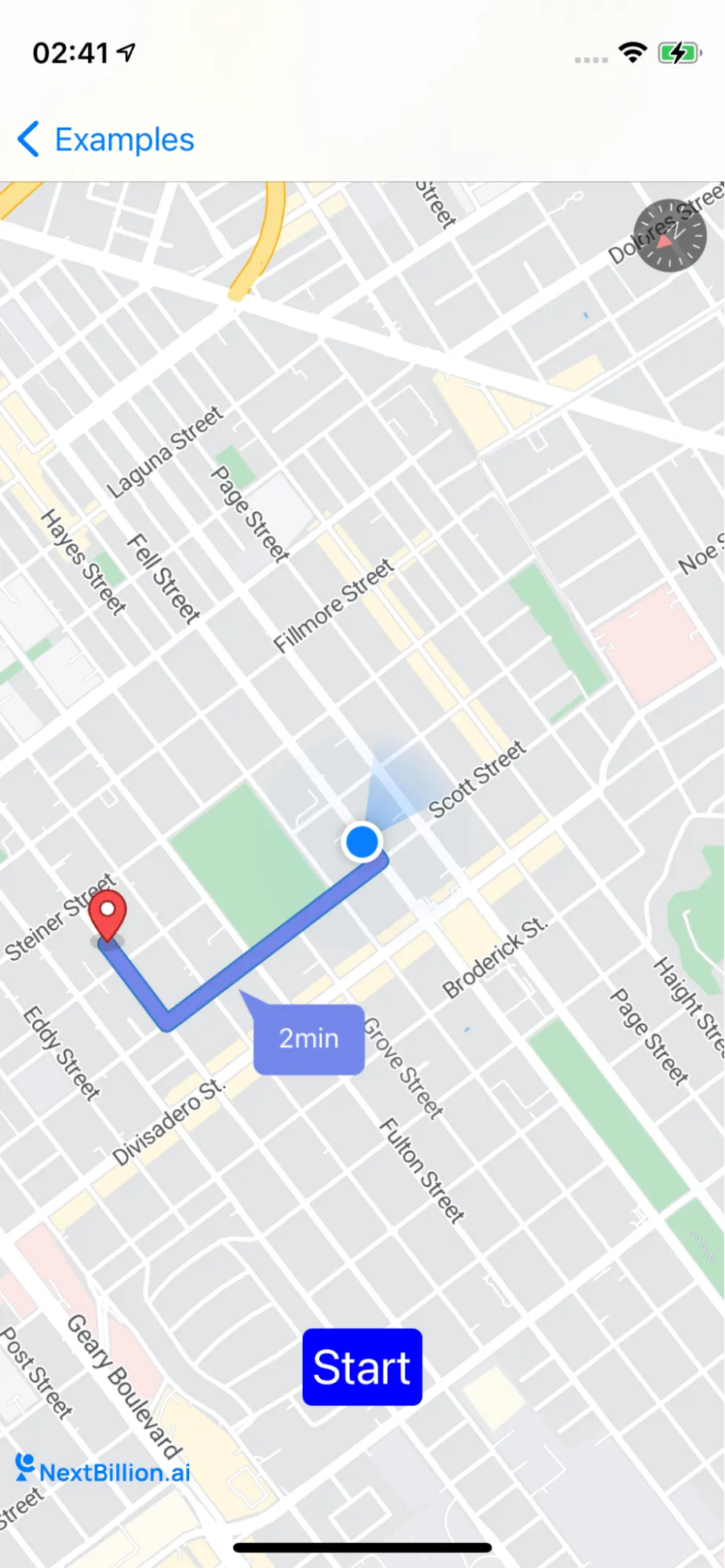Custom Location Source
Customize the location data source for NavigationMapView and Navigation. Obtain location data from user tap actions on the map.
This example shows how to customize your location data source for NavigationMapView and Navigation
-
Custom your location data source for
NavigationMapView, the location data value is from the user tap action on the map -
Custom your location data source for
Navigation

For all code examples, refer to Navigation Code Examples
CustomLocationSourceViewController view source
1import UIKit2import NbmapNavigation3import NbmapCoreNavigation4import NbmapDirections5import Nbmap67class CustomLocationSourceViewController: UIViewController, NGLMapViewDelegate {89var navigationMapView: NavigationMapView? {10didSet {11oldValue?.removeFromSuperview()12if let navigationMapView = navigationMapView {13view.insertSubview(navigationMapView, at: 0)14}15}16}1718var routes : [Route]? {19didSet {20guard routes != nil else{21startButton.isEnabled = false22return23}24startButton.isEnabled = true25}26}2728var currentRouteIndex = 02930var startButton = UIButton()3132override func viewDidLoad() {33super.viewDidLoad()3435navigationMapView = NavigationMapView(frame: view.bounds)3637navigationMapView?.locationManager = CustomMapLocationManager()3839navigationMapView?.userTrackingMode = .followWithHeading4041let singleTap = UILongPressGestureRecognizer(target: self, action: #selector(didLongPress(tap:)))42navigationMapView?.gestureRecognizers?.filter({ $0 is UILongPressGestureRecognizer }).forEach(singleTap.require(toFail:))43navigationMapView?.addGestureRecognizer(singleTap)4445setupStartButton()4647self.view.setNeedsLayout()4849}5051func setupStartButton() {52startButton.setTitle("Start", for: .normal)53startButton.layer.cornerRadius = 554startButton.contentEdgeInsets = UIEdgeInsets(top: 5, left: 5, bottom: 5, right: 5)55startButton.backgroundColor = .blue5657startButton.addTarget(self, action: #selector(tappedButton), for: .touchUpInside)58view.addSubview(startButton)59startButton.translatesAutoresizingMaskIntoConstraints = false60startButton.bottomAnchor.constraint(equalTo: view.safeAreaLayoutGuide.bottomAnchor, constant: -50).isActive = true61startButton.centerXAnchor.constraint(equalTo: view.safeAreaLayoutGuide.centerXAnchor).isActive = true62startButton.titleLabel?.font = UIFont.systemFont(ofSize: 25)63}6465@objc func tappedButton(sender: UIButton) {66guard let routes = self.routes else {67return68}69let navigationService = NBNavigationService(routes: routes, routeIndex: currentRouteIndex,locationSource: CustomNavigationLocationManager())70let navigationOptions = NavigationOptions(navigationService: navigationService)7172let navigationViewController = NavigationViewController(for: routes,navigationOptions: navigationOptions)73navigationViewController.modalPresentationStyle = .fullScreen7475present(navigationViewController, animated: true, completion: nil)76}7778@objc func didLongPress(tap: UILongPressGestureRecognizer) {79guard let navigationMapView = navigationMapView, tap.state == .began else {80return81}82let coordinates = navigationMapView.convert(tap.location(in: navigationMapView), toCoordinateFrom: navigationMapView)83// Note: The destination name can be modified. The value is used in the top banner when arriving at a destination.84let destination = Waypoint(coordinate: coordinates, name: "\(coordinates.latitude),\(coordinates.longitude)")85addNewDestinationcon(coordinates: coordinates)8687guard let currentLocation = navigationMapView.userLocation?.coordinate else { return}88let currentWayPoint = Waypoint.init(coordinate: currentLocation, name: "My Location")8990requestRoutes(origin: currentWayPoint, destination: destination)91}929394func addNewDestinationcon(coordinates: CLLocationCoordinate2D){95guard let mapView = navigationMapView else {96return97}9899if let annotation = mapView.annotations?.last {100mapView.removeAnnotation(annotation)101}102103let annotation = NGLPointAnnotation()104annotation.coordinate = coordinates105mapView.addAnnotation(annotation)106}107108func requestRoutes(origin: Waypoint, destination: Waypoint){109110let options = NavigationRouteOptions(origin: origin, destination: destination)111112Directions.shared.calculate(options) { [weak self] routes, error in113guard let weakSelf = self else {114return115}116guard error == nil else {117print(error!)118return119}120121guard let routes = routes else { return }122123124// Process or display routes information.For example,display the routes,waypoints and duration symbol on the map125weakSelf.navigationMapView?.showRoutes(routes)126weakSelf.navigationMapView?.showRouteDurationSymbol(routes)127128guard let current = routes.first else { return }129weakSelf.navigationMapView?.showWaypoints(current)130weakSelf.routes = routes131}132}133}134135136CustomMapViewLocationManager View source137import Nbmap138import CoreLocation139class CustomMapViewLocationManager: NSObject,NGLLocationManager {140141var delegate: NGLLocationManagerDelegate? {142didSet {143locationManager.delegate = self144}145}146147// Replace with your own location manager148private let locationManager = CLLocationManager()149150var headingOrientation: CLDeviceOrientation {151get {152return locationManager.headingOrientation153}154set {155locationManager.headingOrientation = newValue156}157}158159var desiredAccuracy: CLLocationAccuracy {160get {161return locationManager.desiredAccuracy162}163set {164locationManager.desiredAccuracy = newValue165}166}167168var authorizationStatus: CLAuthorizationStatus {169if #available(iOS 14.0, *) {170return locationManager.authorizationStatus171} else {172return CLLocationManager.authorizationStatus()173}174}175176var activityType: CLActivityType {177get {178return locationManager.activityType179}180set {181locationManager.activityType = newValue182}183}184185@available(iOS 14.0, *)186var accuracyAuthorization: CLAccuracyAuthorization {187return locationManager.accuracyAuthorization188}189190@available(iOS 14.0, *)191func requestTemporaryFullAccuracyAuthorization(withPurposeKey purposeKey: String) {192locationManager.requestTemporaryFullAccuracyAuthorization(withPurposeKey: purposeKey)193}194195func dismissHeadingCalibrationDisplay() {196locationManager.dismissHeadingCalibrationDisplay()197}198199func requestAlwaysAuthorization() {200locationManager.requestAlwaysAuthorization()201}202203func requestWhenInUseAuthorization() {204locationManager.requestWhenInUseAuthorization()205}206207func startUpdatingHeading() {208locationManager.startUpdatingHeading()209}210211func startUpdatingLocation() {212locationManager.startUpdatingLocation()213}214215func stopUpdatingHeading() {216locationManager.stopUpdatingHeading()217}218219func stopUpdatingLocation() {220locationManager.stopUpdatingLocation()221}222223deinit {224locationManager.stopUpdatingLocation()225locationManager.stopUpdatingHeading()226locationManager.delegate = nil227delegate = nil228}229230}231// MARK: - CLLocationManagerDelegate , Please replace with your location data source delegate232extension CustomMapLocationManager : CLLocationManagerDelegate {233234func locationManager(_ manager: CLLocationManager, didUpdateLocations locations: [CLLocation]) {235delegate?.locationManager(self, didUpdate: locations)236}237238func locationManager(_ manager: CLLocationManager, didUpdateHeading newHeading: CLHeading) {239delegate?.locationManager(self, didUpdate: newHeading)240}241242func locationManagerShouldDisplayHeadingCalibration(_ manager: CLLocationManager) -> Bool {243return delegate?.locationManagerShouldDisplayHeadingCalibration(self) ?? false244}245246func locationManager(_ manager: CLLocationManager, didFailWithError error: Error) {247delegate?.locationManager(self, didFailWithError: error)248}249250@available(iOS 14.0, *)251func locationManagerDidChangeAuthorization(_ manager: CLLocationManager) {252delegate?.locationManagerDidChangeAuthorization(self)253}254}255256257CustomNavigationLocationManager view source258import NbmapCoreNavigation259import CoreLocation260class CustomNavigationLocationManager : NavigationLocationManager {261262override var delegate: CLLocationManagerDelegate? {263didSet {264locationManager.delegate = self265}266}267268// Replace with your own location manager269private let locationManager = CLLocationManager()270271override var headingOrientation: CLDeviceOrientation {272get {273return locationManager.headingOrientation274}275set {276locationManager.headingOrientation = newValue277}278}279280override var desiredAccuracy: CLLocationAccuracy {281get {282return locationManager.desiredAccuracy283}284set {285locationManager.desiredAccuracy = newValue286}287}288289override var authorizationStatus: CLAuthorizationStatus {290if #available(iOS 14.0, *) {291return locationManager.authorizationStatus292} else {293return CLLocationManager.authorizationStatus()294}295}296297override var activityType: CLActivityType {298get {299return locationManager.activityType300}301set {302locationManager.activityType = newValue303}304}305306@available(iOS 14.0, *)307override var accuracyAuthorization: CLAccuracyAuthorization {308return locationManager.accuracyAuthorization309}310311@available(iOS 14.0, *)312override func requestTemporaryFullAccuracyAuthorization(withPurposeKey purposeKey: String) {313locationManager.requestTemporaryFullAccuracyAuthorization(withPurposeKey: purposeKey)314}315316override func dismissHeadingCalibrationDisplay() {317locationManager.dismissHeadingCalibrationDisplay()318}319320override func requestAlwaysAuthorization() {321locationManager.requestAlwaysAuthorization()322}323324override func requestWhenInUseAuthorization() {325locationManager.requestWhenInUseAuthorization()326}327328override func startUpdatingHeading() {329locationManager.startUpdatingHeading()330}331332override func startUpdatingLocation() {333locationManager.startUpdatingLocation()334}335336override func stopUpdatingHeading() {337locationManager.stopUpdatingHeading()338}339340override func stopUpdatingLocation() {341locationManager.stopUpdatingLocation()342}343344deinit {345locationManager.stopUpdatingLocation()346locationManager.stopUpdatingHeading()347locationManager.delegate = nil348delegate = nil349}350351}352// MARK: - CLLocationManagerDelegate353extension CustomNavigationLocationManager : CLLocationManagerDelegate {354355func locationManager(_ manager: CLLocationManager, didUpdateLocations locations: [CLLocation]) {356delegate?.locationManager!(self, didUpdateLocations: locations)357}358359func locationManager(_ manager: CLLocationManager, didUpdateHeading newHeading: CLHeading) {360delegate?.locationManager!(self, didUpdateHeading: newHeading)361}362363func locationManagerShouldDisplayHeadingCalibration(_ manager: CLLocationManager) -> Bool {364return delegate?.locationManagerShouldDisplayHeadingCalibration!(self) ?? false365}366367func locationManager(_ manager: CLLocationManager, didFailWithError error: Error) {368delegate?.locationManager!(self, didFailWithError: error)369}370371@available(iOS 14.0, *)372func locationManagerDidChangeAuthorization(_ manager: CLLocationManager) {373delegate?.locationManagerDidChangeAuthorization!(self)374}375}376
